 Warm sunlight on morning mist This is another photo from my latest trip out to Ministik. It was a gorgeous, calm morning: warm enough to be comfortable, but cool enough to keep the mosquitoes down and the mist rising from the lakes.
A few of my prints have come out with slight colour casts, usually a (very little) bit greenish, so I tried this one tonight as the colour of the rising mist is very important to the feel of the photograph. We’ll see how it turns out…
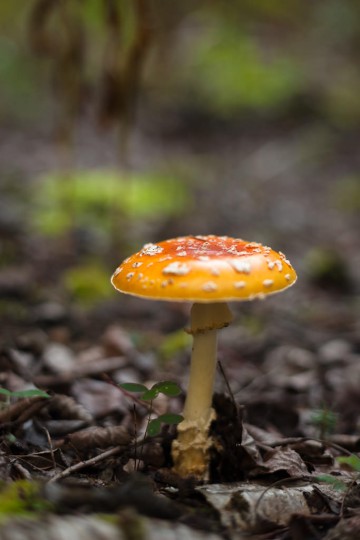 Fresh amanita mushroom Almost exactly two years ago (less one day), I had the opportunity to photograph a tremendous diversity of mushrooms at Ministik (click here to view a gallery of images). Today, I went back to the same spot and, while the diversity was much lower than the previous year, there were some great mushrooms out—and I had a great time photographing a few of them. This is a very fresh, still growing “Fly Agaric” or “Fly Amanita” mushroom (Amanita muscaria). Beautiful to look at—and photograph—but don’t eat it!
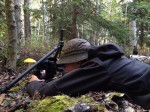 me photographing mushroom For most of the morning, I used my 50mm f/1.4 and flipped the centre column of my tripod upside down to make low-angled, shallow depth-of-field photographs of these mushrooms. I see mushrooms like this often while doing field work, but rarely have the time to take deliberate, careful photos of them. I’ll share a couple more from this morning in the next little while, so please come back again soon. (Here’s a quick photo of my hard at “work” this morning…)
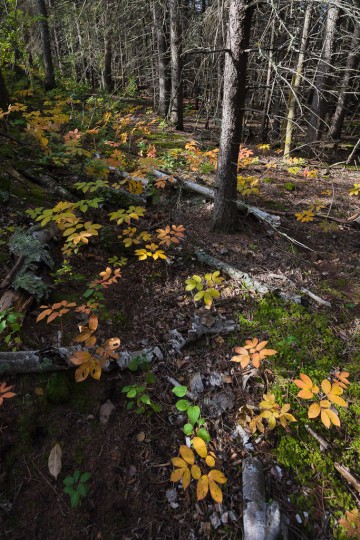 First fall colour So, I’m back from my work in Fort McMurray, I’ve had a chance to rest up a bit, and I’m looking forward to resuming my project of making a new print every day. Just a simple print today from a photograph that I took early last September at the Ministik Game Bird Sanctuary. I’m headed out to Ministik tomorrow morning for the first time in a long while, and hope to come back with some new photographs that I can share here.
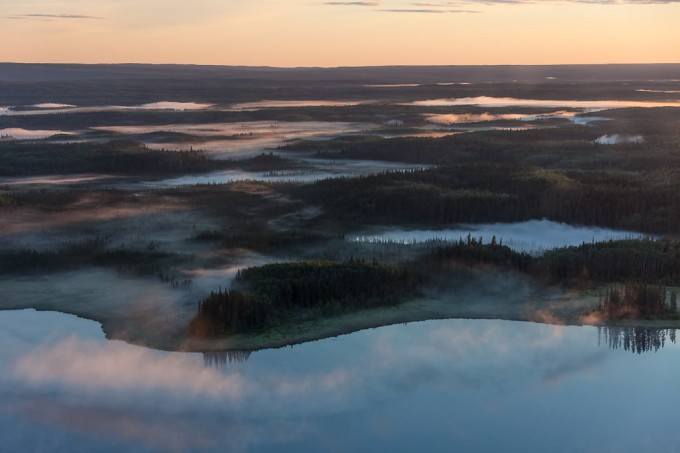 Morning fog over boreal lakes Here’s another photo that I took from the chopper on my way to work one morning last shift. It’s from a different morning as the previous photo, but from the same general area—near Namur Lake in northern Alberta (~100 km northwest of Fort McMurray).
This was a tricky image to print. I tried to get the balance right between detail in the shadows, but still having the landscape dark with just the top of the fog lightening as the sun first peaks over the horizon. It was also hard to figure out the right white balance to use—the Auto WB on my camera was quite cool (very blue shadows), and setting it to Daylight WB made everything very orange-y. I set a manual balance somewhere in the middle, leaning towards cool—does anyone know a good tip for setting white balance for sunrise/sunset so accurately represent how the scene was perceived at the time?
This’ll be my last post for a little while as I’m going up for another shift, but hopefully I will return with many more new photos to share!
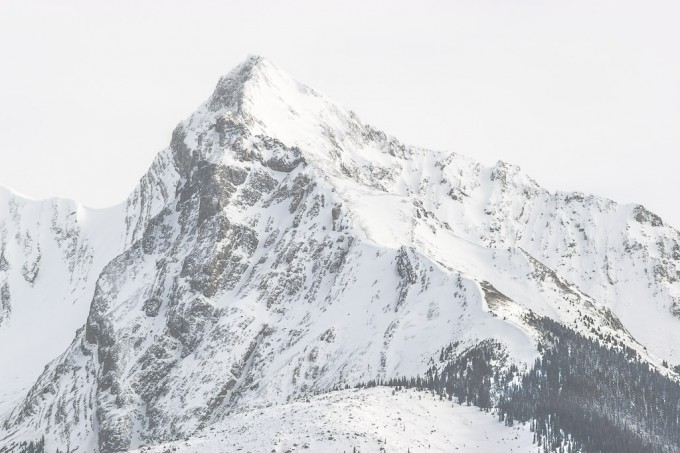 Leah peak in bright winter light Yesterday I printed a very dark, night-time image, so I thought today I’d go the other direction, and print a very bright, winter daylight image. Leah Peak is on the east shore of Maligne Lake in Jasper National Park, and in my opinion, one of the most subtle yet striking mountain in the area.
I took this photo on a very bright day and it was a bright image straight out-of-camera. In Lightroom I did my best to make the print as bright as possible while retaining good contrast and detail in the highlights. I also tried converting it to black-and-white, but I found that I missed the very slight blue in the shadows and warmer sun light on the shoulders of the ridge.
And, just for the interest of the real photo geeks—here are the histograms from yesterday’s photo and from today’s:
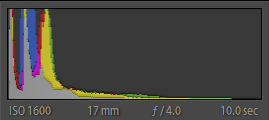 low-key  high-key
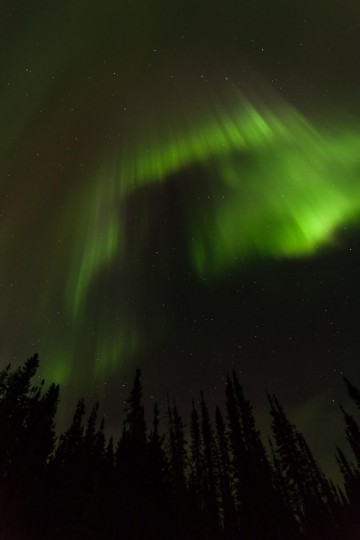 Aurora borealis over black spruce forest Finally—a photograph of the Aurora Borealis on borealisimages.ca! (Although, for the record, the title I’ve given these galleries—‘Silvicola borealis Images’—is derived from latin roots, and roughly translates to ‘inhabiting the northern forest’. The prefix ‘silvi’ (or ‘silva’) relates to the forest, as in ‘silviculture’ which is the practice of growing and tending a forest. ‘Borealis’ refers generally to things northern in nature, and is from ‘Boreas’ — the Greek god of the north wind.)
This is definitely the darkest photo that I’ve ever printed, and I’m quite happy with the way it turned out—the print literally felt heavy with ink! On-screen, I could see a little bit of detail still in the spruce trees, but I can’t see any of that in the print yet. We’ll see if viewing it in bright daylight will reveal some of those darkest details, but otherwise I think they look fine as solid silhouettes too.
I took this photo in northern Alberta while doing owl surveys this past spring. It was the first time I’d photographed the northern lights, and it was a lot of fun to try out a whole bunch of different techniques, equipment, and of course, patience… I’ll be doing a round of bat surveys in the next little while, and I hope to get the chance to apply some of what I learned this spring to making more images of these beautiful northern lights.
(Click to enlarge the image—you should be able to see the stars in the full-size image too!)
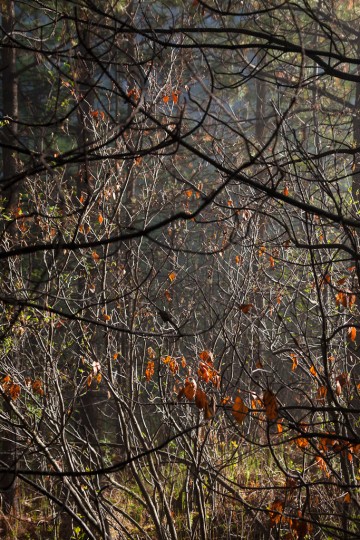 Morning light in young pine stand This patch of forest was pretty much the opposite of the one in yesterday’s photograph—it was a thick, messy, second-growth tangle of young pine, alder, and other shrubs. But when the fog started burning off, and the first strong rays of sun started piercing through to the forest floor it was so beautiful, it almost made up for how soaking wet I was walking through it (and it smelled amazing too!)
Finding an interesting composition in the dense boreal understory is one of my favourite photographic challenges. If you’re interested in this photo, I have a portfolio of similar images entitled “Branches”. You can find it by clicking here, or following the navigation bar up top. Here’s the description that I wrote for that portfolio:
“There are times when I stop while walking through the dense understory common in the boreal forest and aspen parkland to admire the complex beauty of the entwined branches, willows, grasses, and leaves. Then I bring my camera up, and as I look through the lens the complexity turns to chaos as the lens compresses the scene onto a two-dimensional plane. This is when the challenge (and fun) begins. By moving the camera a few degrees to one side, changing the focal length by a few millimeters, or opening the aperture a few stops, a composition may be found that is balanced, pleasing to the eye, and captures some of the beauty entangled in these forests.”
|
(Click photos to enlarge)
|











